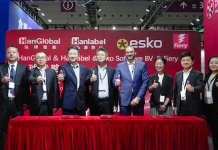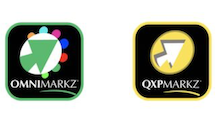By Meggan McCarthy
Africa Print was invited to the Xerox INKjet-Setters Summit 2018 in Marseille, from 17-18 October. The event placed visitors from more than 30 countries at the centre of what’s happening in the world of inkjet and highlighted inkjet’s expanding capabilities that prime businesses for profitable growth. Presentations were held at the Intercontinental Hotel Dieu, followed by a trip to the Xerox Inkjet Innovation Centre in Aubagne.
'There is a huge opportunity in South Africa for inkjet printing,' said Keith Knott, Sales Operations Manager: PSG, Bytes Document Solutions, the world's largest Xerox distributor. 'With the focus on education, and the quality now available with inkjet printing, it will change the printing environment completely. Many of our South African customers are changing their businesses to stay competitive in the market place. More than that, they need to stay relevant. Inkjet printing can assure both.'
Knott said that book printing is making a big comeback, and again inkjet is the perfect solution for this. The quality is good enough for most books, and the volume that can be produced will make the production of books viable to most medium to large printers. He said that direct marketing in the form of coupons, catalogues and more by major retailers will change the way customers and retailers interact. 'Those that buy-in, will become more relevant. The only concern in South Africa is the postal system.'
'With our very restrictive labour laws, as well as the high cost of labour in South Africa, more and more companies are looking at ways to be less dependent on manual labour, and more on automated processes, in order to produce higher volumes and better quality at reduced costs. In the right environment, inkjet can do all of the above for our customers,' added Knott.
Intersection of the physical and digital worlds
Hubert Soviche, Vice President of Graphic Communications Solutions Group within International Operations, kicked off the event. 'In an industry that produces paper-based marketing material by the ton, profitable growth is found at the intersection of the physical sheet of paper and the digital webpage. Digital allows print providers to help their customers blur the line between these physical and digital worlds,' he said. 'This is why Xerox hosts the INKjet-setters Summit. This showcase of ground-breaking technology allows print providers to hear from industry leaders and partners who found profitable growth at the intersection of the physical and the digital worlds.'
Soviche stated that production inkjet print will account for 51% of the total production of digital page volume by 2021 and that the digital print market is expected to reach $153 billion by 2021 (Smithers-Pira, 2016). He said that advances in inkjet have seen an increase in speed and quality and the range of paper weights that can run through the press has also expanded.
Elevating the print partnership by tapping into the psychology of choice
Jeanette McMurtry, e4marketing Digital Transformation, gave the keynote speech on Forging Winning Partnerships Across Strategy Lines, addressing the importance of printers providing engaging content that can go deep into the consumer psyche and influence choice. According to McMurtry, what we say is not what we think – 90% of our thoughts, attitudes and behaviour are unconscious, so printers who understand consumers' emotional and unconscious triggers will give themselves the edge by being able to advise clients on creating the most impactful campaigns. 'Marketers are largely appealing to the conscious mind so they are only marketing to 10% of the decision making process. That means your client's campaign is wasting 90% of resources. When you advise your clients to market to the unconscious mind, the campaign will be much more impactful.'
Of course, printers don't have to obtain a degree in psychology for this. Even understanding the power of colour to trigger specific emotions will set them apart. For example, within 90 seconds, consumers make an unconscious judgement of a product or environment, and 60-90% of that judgement is based upon colour. Knowing which colours trigger which emotions is key. For pricing collateral, knowing the correct sizing of numbers and whether to use currency values or percentages (the dollar amount vs. percentage for prices of $100 or more always works better, according to Jonah Berger) will help make printers indispensable partners.
McMurtry said that printers need to tap into the power of psychological personalisation. Printers can blend digital and print by using tools such as augmented reality to make the consumer experience more real and engaging. 'Advertising doesn't influence choice, behaviour and purchases, it's communications that engage what really matters to the heart and soul of the consumer or buyer.'
'Print is powerful. It outperforms digital by twice as much, and printed communications and direct mail outperforms email by three times as much. It also achieves 30% more recall than digital means, which translates into consumer response, then purchases and hopefully brand loyalty. It's built upon the emotional triggers of choice, which screens simply don't connect with.'
Human nature is wired for touch. 'We engage better and we purchase more. You can be a partner to brand owners and your customers because you have the technology that provides personalisation at a high level, that taps into that power of human touch, that engages us consciously and unconsciously. The opportunity could not be better, and the opportunity is now,' she added.
Tips for printers who want to move from a Print Service Provider to a Marketing Services Provider:
– Be consultants, not order takers. You need to consult about personalisation, by going beyond the transactional value and tapping into the psychology of choice.
– Integrate digital with print for total engagement.
– Elevate your partnership with customers – you are not providers but rather partners in consulting, ideas, intelligence and technology.
– Test the work you do for clients. When you do this, you take the ad agency out of the equation and you get more of the budget share.
Triggered direct mail
Personalised, data-driven communications increase responses – 70% of consumers are more likely to open communications if they are personalised (InfoTrends 2015). Printers have the potential to blend print, digital, data and consulting with triggered direct mail, which puts puts customers at the centre and gets results for marketers. Based on the action a consumer takes on your website, a particular 'trigger' determines the type of printed message. The communication is mailed quickly, within 24 to 48 hours, while the action and motive are fresh in the consumer’s mind. As a result, the attention of a highly qualified prospect may be captured at the peak of their purchasing probability. Examples include: postcards, letters, self-mailers, catalogues, loyalty offers, manuals and service coupons.
'Retailers and brand owners want to have relevant and consistent dialogue with their consumers across all the channels, and print and digital are mechanisms through which they can do that,' said Jonathan Edwards, Vice President for Global Business Development, Xerox. 'The solution that we have is an integration of our own and our partners' technologies, which brings something unique, specifically regarding XMPie, and we're able to deal with print and digital at the same level of importance to bring that consistent message to the consumer.'
Xerox customer Katell Paul, Managing Director of Docapost, addressed how the company found success with hyper personalised postcards for client Yves Rocher, a worldwide cosmetics and beauty brand. Docapost needed to find a better way to print hyper personalised content on high- end media while retaining the attractive economics of inkjet. The company was impressed by the offset-like quality and gamut of the Xerox Trivor 2400 HF Inkjet Press, which offered the perfect balance of vibrant quality, high-volume productivity, and outstanding economics – all from one adaptable system.
Its ability to print directly on a vast array of glossy offset papers – including heavyweight postcard stocks – without any pre-treatment or coating allows them to eliminate the time and expense involved with procuring inkjet coated media. Additionally, the fact that Trivor uses less ink than other inkjet presses meant it would reduce their production costs overall. The press’ print speed also reduces delays in production, improving their customer service and turnaround times and providing significant flexibility when it comes to meeting client needs for on-demand campaigns.
Xerox Inkjet Offerings
Attendees were also given insight into the new innovations in Xerox's inkjet offerings. The Brenva HD production inkjet press now offers an optional Speed Kit to enable print speeds up to 300 images per minute, duplex. Xerox has increased output capacity for the press by 40 percent, expanded stock choices and added a roll feed capability for continuous operation. With the new duplex speed kit, Brenva HD’s output speed increases from 197 to 275 A4 pages per minute, allowing print providers to take advantage of the inkjet value proposition, high quality and high output for key application areas.
The new kit increases productivity by speeding up duplex (two-sided) printing, which is essential for books and manuals, as well as many transactional jobs. Depending on the sheet size used, print providers can now achieve up to 300 A4 size impressions per minute with the press. Working with technology partner, Tecnau, Xerox now offers the Tecnau SheetFeeder BV roll feed system for up to nine hours of non-stop cut sheet paper feeding. The book, transactional and direct mail segments are all expected to have double digit compound annual growth rates in production inkjet pages by 2022 (IT Strategies’ The Production Cut-Sheet Inkjet Market, July 2018). With Brenva HD’s increased output and new roll feed capabilities, print providers can grow profitability by reducing run costs and increasing capacity.
Another innovation is the Trivor 2400’s new Color Hike technology, which delivers quality that continues to move up the spectrum towards the offset benchmark — making inkjet even more accessible to a wider range of applications that have demanding quality standards, such as direct mail, books, catalogs and general commercial work. Trivor 2400 also gives operators the option to adjust drop size and vibrancy on a job-by-job basis to meet exact customer specifications.
‘It was a pleasure to attend the INKjet-Setters Summit 2018, which was well-organised and exceptionally insightful for all in attendance, said Philippe De Coster, an attendee from South Africa. ‘The keynote speakers were great, highlighting how technology has evolved and grown through innovation and dedication. I am excited for what the future holds. The technology has come a long way, and the possibilities are endless.’





















